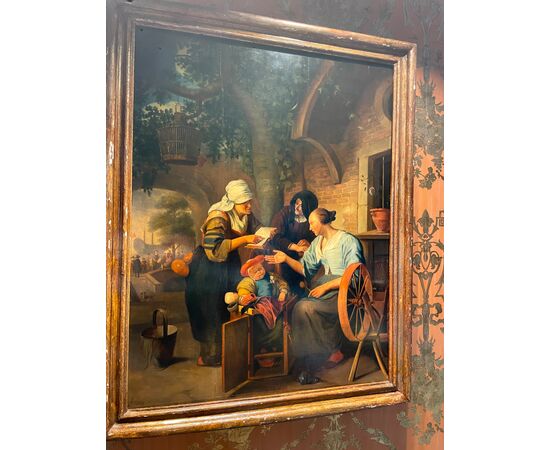NOT ACTIVE Jan Havickszoon Steen, The Fortune Teller, oil on panel, mid-17th century
Jan Havickszoon Steen, The Fortune Teller, oil on panel, mid-17th century
Oil on panel. Dimensions: Frame: cm H 89.5 x W 71 x D 6; panel: cm H 80.5 x W 64.5
Price: private negotiation
Item accompanied by our certificate of authenticity
The fine painting, executed in oil on panel, depicts a genre scene in which a fortune teller, holding a book to read fortunes, illustrates her interpretation to a young woman sitting in front of her, while an elderly woman with a covered head watches curiously. The young woman, perhaps a spinner, as suggested by the spinning wheel depicted next to her, holds a biscuit in her hand. On a small wooden chair, a child has fallen asleep, still holding two dolls in its arms. It is a scene of everyday life of humble people, set outdoors in a courtyard in front of a brick house. A tree and an arch in the background create a backdrop, making the environment intimate and welcoming. Beyond the arch, a bustling crowd enlivens what must be a road running along the seashore. In the distance, a galleon can be seen. The work features a meticulous description of details: the painter inserts various details and small objects that, in addition to animating the scene, provide precise information about life in the Golden Age in Holland. The high pictorial and stylistic quality, the descriptive and compositional rendering, are clearly an artistic expression of a master. The work is signed lower left "JSteen". This is the famous Dutch painter Jan Havickszoon Steen (Leiden, 1626 –1679), one of the most established artists in 17th-century Holland. His extensive production includes both genre scenes and mythological and biblical subjects, self-portraits, still lifes and landscapes. His favorite theme was everyday life, especially of the middle and lower classes of society, which he portrays in their ordinary habits or in festivities, sometimes implying allegorical or moralizing meanings. Psychological introspection, irony and a lively chromatic palette are the characteristics that distinguish his style. Jan Steen was born in Leiden, into a wealthy Catholic family. He trained with Nicolaes Knüpfer, a German painter known for his historical or narrative paintings set in Utrecht. His painting was also influenced by Adriaen van Ostade, a painter of rural scenes, who lived in Haarlem, although it is not known if there was any contact between the two. In 1648 Steen was among the founders of the Sint-Lucasgilde ("Guild of Saint Luke") of Leiden, and shortly after, he became an assistant in The Hague to the renowned landscape painter Jan van Goyen. On 3 October 1649 he married Margriet, daughter of van Goyen, with whom he had eight children. Steen worked with his father-in-law until 1654. He then lived in Delft, Warmond and Haarlem, where he was very productive. In 1670, following the death of his father and that of his wife, which occurred a year earlier, Steen returned to Leiden, where he had inherited his father's house, in which he lived until his death.
The painting, in good condition, is presented within an antique gilded mecca frame.

